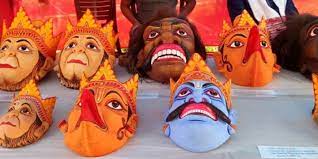- Courses
- GS Full Course 1 Year
- GS Full Course 2 Year
- GS Full Course 3 Year
- GS Full Course Till Selection
- Answer Alpha: Mains 2025 Mentorship
- MEP (Mains Enrichment Programme) Data, Facts
- Essay Target – 150+ Marks
- Online Program
- GS Recorded Course
- NCERT- First Ladder
- Polity
- Geography
- Economy
- Ancient, Medieval and Art & Culture AMAC
- Modern India, Post Independence & World History
- Environment
- Governance
- Science & Technology
- International Relations and Internal Security
- Disaster Management
- Ethics
- Current Affairs
- Indian Society and Social Issue
- CSAT
- 5 LAYERED ARJUNA Mentorship
- Public Administration Optional
- ABOUT US
- OUR TOPPERS
- TEST SERIES
- FREE STUDY MATERIAL
- VIDEOS
- CONTACT US
GI Tag - Cuttack’s Famed Silver Filigree Work And Majuli Masks Of Assam
GI Tag - Cuttack’s Famed Silver Filigree Work And Majuli Masks Of Assam
- In March, 2024 The Majuli manuscript and traditional Majuli masks in Assam were given a Geographical Indication (GI) tag by the Centre.
- painting also got the GI label.
- The famous Cuttack Rupa Tarakasi (Silver Filigree) was also given the GI tag certification.
Majuli masks in Assam
1. Majuli is the largest river island in the world. It is also the seat of Assam’s neo-Vaishnavite tradition. The root of Majuli masks is situated in the river island district of Majuli in Assam.
2. The handmade masks are traditionally used to depict characters in bhaonas, or theatrical performances with devotional messages under the neo-Vaishnavite tradition.
- It was introduced by (during 15th - 16th century) reformer saint Srimanta Sankardeva.
 3. The masks can depict gods, goddesses, demons, animals and birds — Ravana, Garuda, Narasimha, Hanuman, Varaha Surpanakha all feature among the masks.
3. The masks can depict gods, goddesses, demons, animals and birds — Ravana, Garuda, Narasimha, Hanuman, Varaha Surpanakha all feature among the masks.
4. According to the application made for the patent, the masks are made of bamboo, clay, dung, cloth, cotton, wood and other materials available in the riverine surroundings of their makers.
5. The art practiced in monasteries. Majuli has 22 sattras, and the mask-making tradition is by and large concentrated in 4 of them — Samaguri Sattra, Natun Samaguri Sattra, Bihimpur Sattra and Alengi Narasimha Sattra.
Majuli Manuscript Painting
- It is a form of painting.
- Originated in 16th century done on Sanchipat, or manuscripts made of the bark of the Sanchi/agar tree, using homemade ink.
- The earliest example of an illustrated manuscript is said to be a rendering of the Adya Dasama of the Bhagwat Purana in Assamese by Srimanta Sankardev.
- These painting were patronished by the Ahom kings.
- It continues to be practiced in every Sattra (monasteries) in Majuli.
Rupa Tarakasi, Odisha
- Odisha’s Cuttack is known for its silver filigree work, of intricate design and fine craftsmanship.
- In Odia, “tara” means wire and “kasi” means to design. Thus, as part of Rupa Tarakasi, silver bricks are transformed into thin fine wires or foils and used to create jewellery or showpieces.
- While the exact origin of the filigree art in Cuttack is not clear, it is known to have existed as far back as the 12th century. The art form received considerable patronage under the Mughals.
- In Cuttack the work is generally done by boys, whose sensitive fingers, and keener sight enable them to put the fine silver threads together with the necessary rapidity and accuracy.
- The popular product categories now found in Cuttack are jewellery, decorative artifacts, accessories, home décor and religious/cultural pieces.
- The iconic items found only in Cuttack are the Durga Puja Medha (silver decorations for the Durga idol and pandal), Odissi jewellery, religious/cultural pieces linked directly to the customs of Odisha, and the Dama chain.

About GI tag
- Geographical Indications (GI) is defined under Article 22(1) of the WTO agreement on Trade-Related Aspects of Intellectual Property Rights (TRIPS).
- The GI of Goods (Registration and Protection) Act was enacted in India in September 2003.
- A Geographical Indication (GI) tag is a distinctive sign used to identify products originating from a specific geographical location, possessing unique qualities, characteristics or reputation attributable to that region.
- It serves as a form of intellectual property, acting as a certification of the product's authenticity and origin.
- The GI tag confers legal protection, allowing registered authorized users to prevent misuse and misrepresentation.
- It enables producers to promote their products more effectively, facilitating market access and fetching premium pricing, thereby benefiting local communities and safeguarding traditional knowledge.
- GI tags have been granted to various agricultural, natural and manufactured products across the world, promoting their exclusivity and preserving their cultural heritage.
|
Must Check: Best IAS Coaching In Delhi



